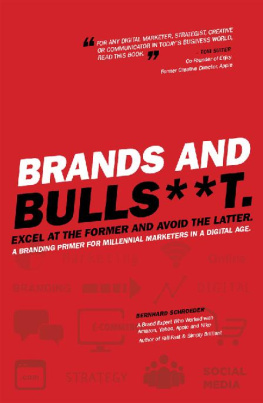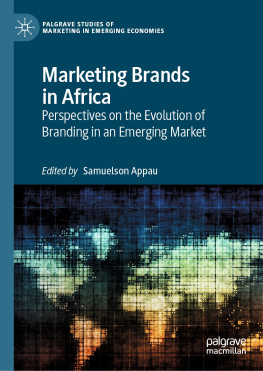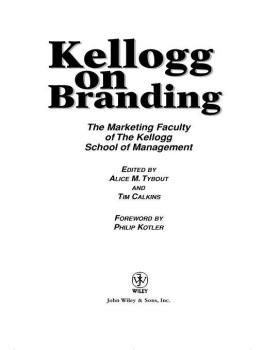Twitter Is Not a Strategy
Rediscovering the Art of Brand Marketing
Tom Doctoroff

The author and publisher have provided this e-book to you for your personal use only. You may not make this e-book publicly available in any way. Copyright infringement is against the law. If you believe the copy of this e-book you are reading infringes on the authors copyright, please notify the publisher at: us.macmillanusa.com/piracy .
Contents
Introduction
Back to the Future
Business is in flux. We suffer from disorientation wrought by technological change. Convention has been upended, and the digital worlda universe of bits and bytes, atomistic fragmentation that mocks traditionis all variables, no constants. The rise of search engines and e-commerce has changed the balance of power between marketers and consumers. In May 2013 the Financial Times warned, Algorithms threaten to end Mad Men era of TV ads. Marketers, traditionally expert in product development and brand messaging, are now expected to decipher the meaning of statistics flowing from machine-to-machine connectivity. And, given the dizzying pace of innovation occurring in cyberspace, reasonable people can ask: Across unsettled high-tech terrain, is the term digital expert an oxymoron?
CEOs look to the beast itself for salvation, intoxicated by the promise of new ways to maximize return on investment. A typical Business Insider headline: Big Data Can Help Marketers Unlock up to $200 Billion.tumult. In the midst of a digital big bang, the advertising giant TBWA advocates disruption to its clientsthat is, the unsettling of category convention to achieve competitive differentiationwhereas Publicis Worldwide wants brands to lead the change. But what change and how?
Digital Salvation?
Digital technology offers an infiniteand intimidatingrange of ways for brands to engage with consumers. Connections can happen in real time. Brand communications can be transformed into brand journalism, with social network feeds providing consumers with relevant news as they go through their day. Branded appsfrom Trailhead, The North Faces hiking path locator, to Allergycast, Johnson & Johnsons pollen index countertransform passively received propositions into actual services. Brand promises flower into three-dimensional experiences.
The gamut of possibilities on this new commercial landscape is almost infinite, too broad for simplistic solutions. More important, the range of strategic imperatives confronted by various product categories is vast, and their needs are incompatible with a paint-by-numbers manual. One thing, however, is certain. Regardless of whether it is cola or computers being sold, the exploding array of digital channels presents increased opportunities to connect and confuse. Unless marketers master the timeless rules of brand building, they will get nowhere. In a hydra-headed digital world, the ultimate commandment of marketing still holds: Consistency is golden. Without long-term ideas behind it, the latest data-mining technique, augmented reality app, or search algorithm will be lost in the background buzz. Technological adventurism will never replace solid, coherent conceptual craftsmanship.
Ideas that stand the test of time are not quaint. Yes, the digital realm presents exciting challenges. But in that excitement its too easy to forget about the consumers themselvesthe desires that drive them and the role brands play in their lives. Remember, consumers too are often baffled by technological change. They are also drawn to brands with clear relevant propositions. Back in 1917 J. Walter Thompson, founder of the eponymous advertising agency, a company that celebrated its 150th anniversary in 2014, uttered these enduring words: Somewhere in your product, or in your business, there is a difference, an idea that can be developed into a story so big, so vital, and so compelling to your public as to isolate your product from its competitors, and make your public think of it as a distinctly different kind of product.
The dazzling new kaleidoscope of choice and the pressures of a hyperconnected, always on digital lifestyle has left more than a few people unsettled. This includes many marketers charged with leading some of worlds greatest brands. In an effort to avoid being branded traditional or obsolete, advertising and marketing professionals fall prey to technological temptation. We furtively deploy the latest or hottest digital innovation without fully considering the basics of brand strategy or message consistency. Consumers end up more confused and less loyal.
In the midst of this disorientation, order can be especially reassuring. The practice of marketing may be evolving, but the fundamentals of brand building are the same today as they were fifty years agothe so-called golden age of advertising. Now more than ever, strong brands command price premiums. Now more than ever, strong brand ideas produce profit.
Only the brand ideathe long-term relationship between consumer and brand that remains steady yet evolves over timecan resolve the tension between traditional brand-building imperatives and the opportunities unleashed by technology and widespread consumer empowerment. Clearly defined yet dynamically interactive, it remains the sine qua non for both consistent messaging and engagement between consumers and brand. Traditional brand building is top-down, articulated by the manufacturer and fueled by message clarity and deep understanding of consumers motivations. The new opportunities offered by technology are bottom-up, unpredictable, on the streetof, by, and for the people. Brand building has existed since the dawn of the industrial revolution; the new opportunities are entirely twenty-first century. Yet they need to coexist within the same discipline.
Plenty of qualified authorities are available to guide readers through the challenges of modern marketing. I am neither a so-called digital expert nor a creative guru. But, as CEO of JWT Asia Pacific, I have had the good fortune of partnering with dozens of clients, both multinational and local, many of whom have succeeded in establishing strong brands in the worlds most dynamic commercial environmentsand some who have not. If I have learned one valuable lesson, it is this: Anxiety is not productive. Brands can lead the change only when their marketing executives have the confidence to go back to the future and rededicate themselves to timeless marketing principles.
This Books Content: Freedom within a Framework
Its time to take a deep breath. With the brand idea as its epicenter, Twitter Is Not a Strategy is designed to forge order from chaos for both marketers and consumers. I offer a four-part framework that unifies conceptual and executional essentials, demonstrating that the brands that address these issues most effectively will always reign supreme, boasting the highest margins and the most loyal consumers.
In the first two chapters I discuss the rise of brands and how digital technology impacts lives and consumer marketing. From video games to social networks that provide new platforms for self-expression to the Uber app that connects passengers with drivers for hire at the tap of a button, the digital world has yielded an explosion of lifestyle opportunities and consumer empowerment. Few people sit passively in front of the television waiting for commercials to interrupt them with information. New technology is two-way, and it enables ongoing dialog between brands and consumers who now demand a voice. They expect to be heard and join in on the funwith brands whose advertising is as involving as any of their other entertainment options. And consumers want to be rewarded for loyalty. They dont want to be talked down to.
Next page







